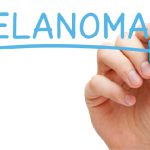Skin cancer can develop in any part of the body, but most often it is developed on skin that is more exposed to the UV radiation. Skin cancer occurs to people of all skin tones. Read more about skin cancer here.
Common types of skin cancer:
The epidermis is made up of three types of cells- basal cells, squamous cells and melanocytes. Cancer that develops in these tissues are the most common skin cancers. Following are these common types of skin cancer:
Basal cell carcinoma (BCC):
The most common type of skin cancer is basal cell carcinoma. Fair people are at a higher risk of developing this type of skin cancer than the dark people. BCC (Basal cell carcinoma) are mostly caused due to frequent exposure to the sun and indoor tanning for many years. They appear like a pearl-like bump or a pinkish patch of skin often found on the neck, head and arms. However, BCCs can develop in any part of the skin including the legs, abdomen and the chest.
Basal cell carcinomas can spread locally and cause damage and disfigurement to the tissues, which is why they have to be diagnosed and treated early. The 5 year survival rate of this cancer is 85% to 95%. Chemotherapy, radiation therapy and surgical procedures are used to treat BCCs. Read more about treatment options for skin cancers here.
Squamous cell carcinoma (SCC):
After basal cell carcinoma, SCC is most likely one. Like other types of skin cancers, men are at a higher risk of developing skin cancer, white men are at an elevated risk than blank men. The cancer occurs as a sore that often heals and reopens or as a red firm bump or a scaly patch. These are mostly observed in areas that are exposed to the sun frequently like the rim of the ear, face, neck, arms, chest, and back. SCC causes damage and disfigurement of the skin. These cancers have to be diagnosed and treated in the early stages to avoid their spreading. Read more about diagnosis of skin cancer here.
This cancer has a survival rate of 85% to 95%. Surgeries are a part of primary treatment to cure squamous cell carcinoma. Chemotherapy, laser surgeries and radiation are given in combination for advanced cancer.
Melanoma:
This is the deadliest skin cancer which develops as a mole or a dark spot that appears suddenly. These cancers require diagnosis and treatment immediately after detection to reduce its adverse effects. The ABCDE warning signs can be used to detect early stages of melanoma.
The 5 year survival rate of melanoma that has been treated in the early stages is 98.4%, while that of regional melanoma is 62.4% and distant metastatic melanoma is 17.9%. Radiation therapy, chemotherapy, immunotherapy, surgical procedures, targeted therapy and clinical trials are used to treat this deadly form of skin cancer.
Rare types of skin cancer:
Out of all the patients who have been diagnosed with skin cancer, only 2% of them have the following cancers:
Merkel cell carcinoma:
This is a very rare type of cancer, which occurs in the Merkel cells. Frequent exposure to the sun causes abnormal growth of these cells which leads to cancer. Merkel cell carcinoma has a very high spreading capability. It often metastasizes to distant lymph nodes and organs in the early stages itself.
The cancer develops firm, painless and fast-growing lumps that are raised or dome-shaped and violet or red in colour.
Cutaneous T-cell lymphoma (CTCL):
When the T-cell lymphocyte becomes malignant, it affects the skin in the form of CTCL. It is most observed in men and women who are above 50 years. Chemotherapy, {insert 6.14} immunotherapy and targeted therapies are used for treating Cutaneous T-cell lymphoma.
Kaposi’s Sarcoma (KS):
This cancer is caused by Kaposi Sarcoma Herpesvirus (KSHV) that affects the cells of the blood or lymph vessels. HIV patients are at a higher risk of developing this type of skin cancer. KS occurs as brown, purple or red blotches or tumours on the skin, causing swelling. Metastasized kaposi’s sarcoma is life threatening.
hemotherapy and immunotherapy are given as treatments to cure KS.
Sebaceous Gland Carcinoma (SGC):
This type of cancer develops in the oil glands. This rare and aggressive form of skin cancer. SGC is often diagnosed in women above 70 years of age. It mostly occurs observed the eye, but can occur on any part of the skin.
Surgical removal of the tumours and radiation therapy are used to treat sebaceous gland carcinoma.
Dermatofibrosarcoma Protuberans (DFSP):
DFSP is a very rare skin cancer tumour that develops as a result of overproduction of a molecule called platelet-derived growth factor, which is caused due to genetic mutations. It occurs in the limbs or trunk of the body and in the dermis of the skin.
Surgeries, radiotherapy along with targeted therapy are recommended to treat this cancer.



